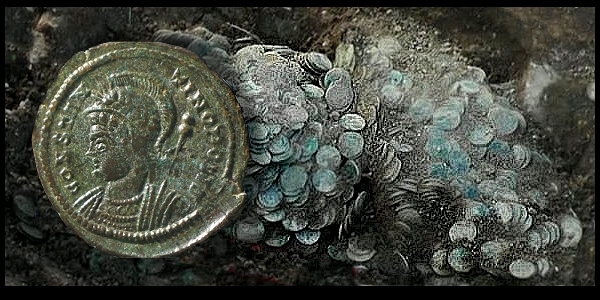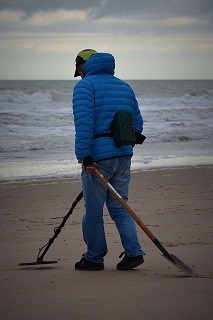The Seaton Down Hoard by Alex Lemaire for CoinWeek …..
Laurence Egerton is a 51-year-old semi-retired builder in the United Kingdom who spends his spare time metal detecting. He doesn’t make a living out of it. For most of the many years he has spent pursuing this hobby, he has dug up little more than rusty pieces of trash. From time to time, he has found one or two precious coins.

That changed, however, in November 2013 when he found a hoard of more than 22,000 Roman coins.
While Laurence was scanning a field in Seaton on the southern coast of the UK with his detector, He got a signal. He dug a hole and, to his surprise, the coins were spilling off of his shovel. The Seaton Down Hoard of Ancient Roman Coins was huge. So he reported his find to the Devon County Council archaeologist, Bill Horner. A group of professional archeologists came to that site and started excavating the coins. They were familiar with the area because they had already excavated ancient Roman sites near this field.
The operation lasted for three days. Many people were on-site during the day but no one was there to guard it in the nighttime. The lucky detectorist didn’t want to leave such a large hoard out in the open, so he decided to park his car near it and sleep there to protect from thieves. This was no easy task; Laurence is a tall man and the car barely fit him and besides, the three nights were very cold.

After the Seaton Down Hoard excavation was complete, the experts examined the coins. Because of the hoard’s large size, they needed 10 months to clean and catalog the pieces and there’s still more work to be done. Coin treatment isn’t a problem for experienced relics conservators; they only need simple tools to clean them one by one, though it is time-consuming (especially for treasures of this size). Chemical methods are faster but they can damage the coins.
In total, the archaeologists unearthed 22,888 coins in the Seaton Down Hoard and three ingots that weighed around 150 pounds. They were in good shape, the rulers and the members of the imperial family that they depict being clearly visible. The coins were issued between 260 and 348 CE by 17 separate mints situated in different places across Europe. Some of the coins were minted in 332, the year the eastern capital of Constantinople was founded.
This hoard was declared a trove due to its historical value. When the coins were actively in circulation, they weren’t considered very precious, and the hoard itself was probably the savings of a Roman soldier or a merchant. The type of coins found at Seaton is called a nummus, which are coins used in everyday purchases. But after staying buried for nearly 1,700 years, the coins are now worth $100,000. This sum will be split between Mr. Egerton as the finder and the landowner upon whose property the find was made.
If you want to take a look at these coins, they are on display at the Royal Albert Memorial Museum, which is a couple of miles from the place where the hoard was discovered. The local museum acquired this collection by launching a fundraising campaign since they had a limited purchasing budget.
* * *
 About the Author
About the Author
Alex Lemaire is passionate about unearthing history and collecting coins and relics. He thinks that metal detectors are time machines that help us know more about our ancestors’ lifestyle. You can follow him on his blog https://metaldetectorplanet.com/




